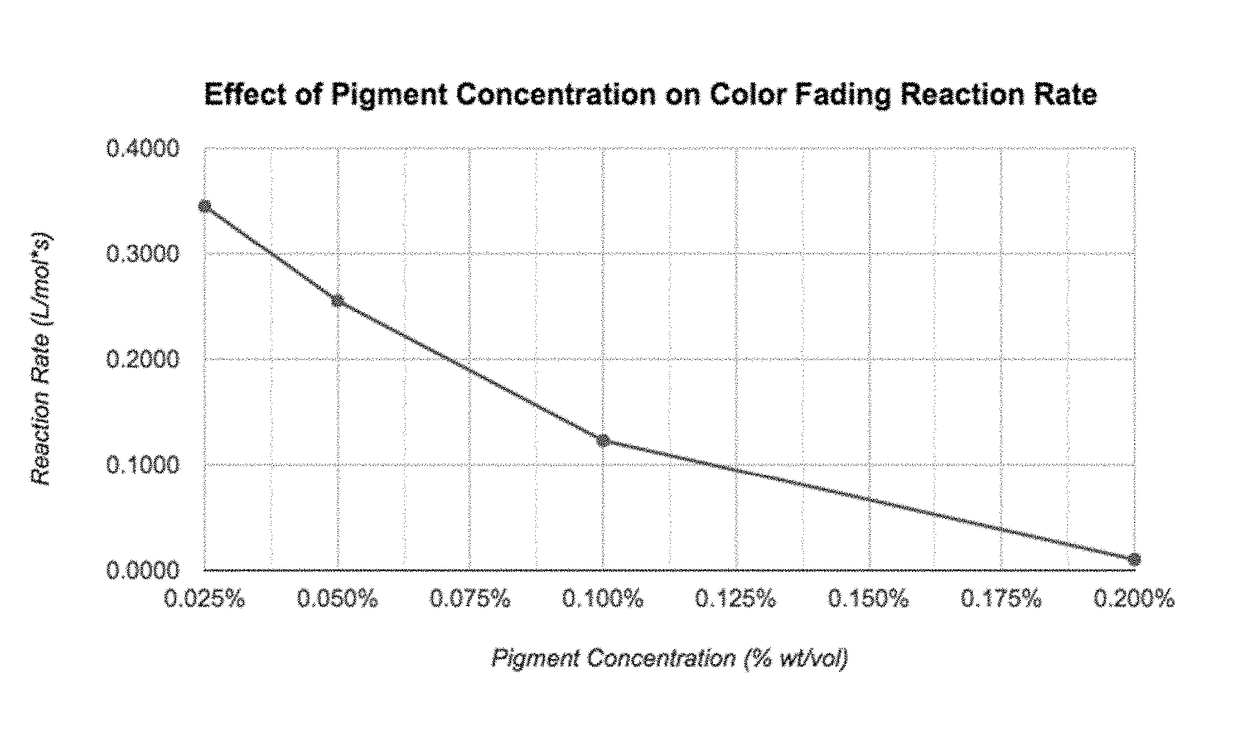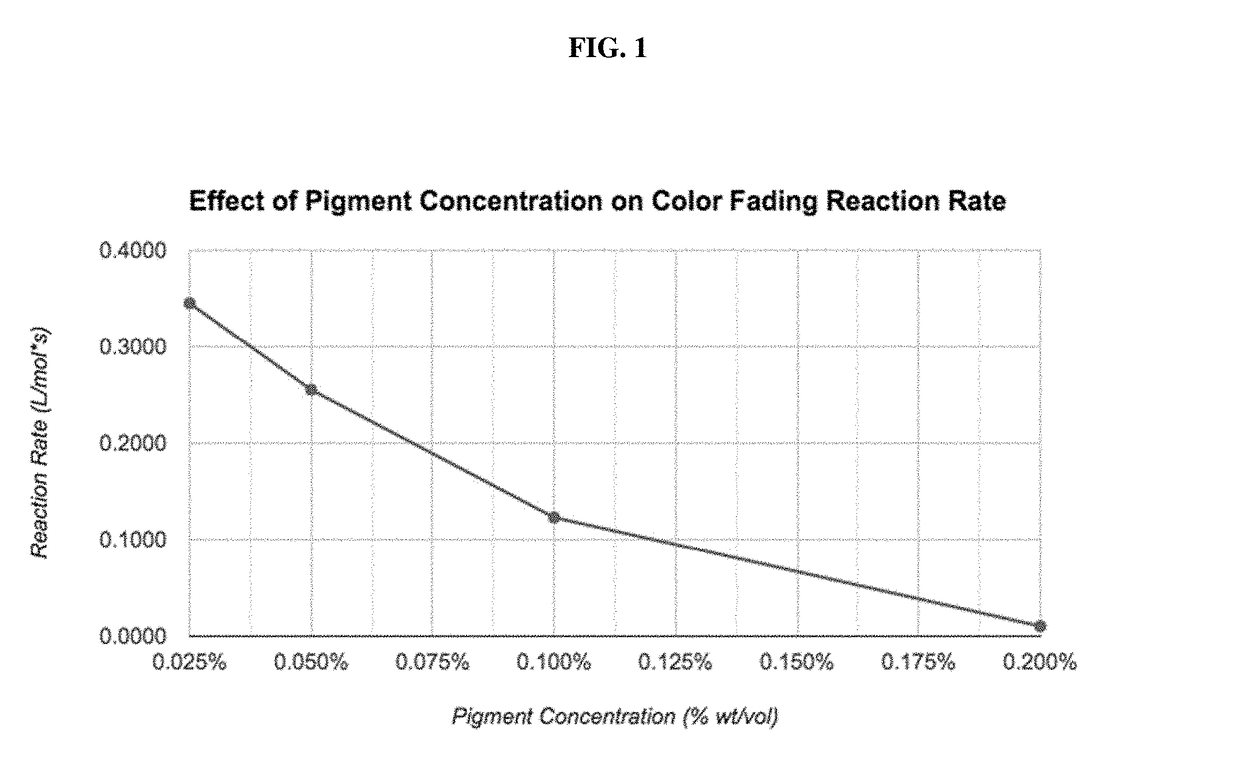Compositions and methods for use in surface decontamination
a technology of disinfectant agents and compositions, applied in the direction of investigating sterilization degree, detergent compounding agents, detergent dyes, etc., can solve the problems of inability to provide proper inability to carry around or install ultraviolet light sources, and inability to provide training on proper removal of personal protective equipment. , to achieve the effect of adequate decontamination or disinfection of the surface, complete coverage of the surfa
- Summary
- Abstract
- Description
- Claims
- Application Information
AI Technical Summary
Benefits of technology
Problems solved by technology
Method used
Image
Examples
example 1
[0121]Powdered compositions were made consisting of:
% Wt. / Wt.Compo-Compo-Compo-Compo-Ingredientsition Asition Bsition Csition DFD&C Blue 11.182.334.558.70Surfactant (SDS)94.1293.0290.9186.96Alkaline builder (NaOH)4.714.654.554.35
[0122]The procedure was to blend the ingredients and stir into 0.525% sodium hypochlorite diluted in water. 200 μl of the resulting mixtures was pipetted in quadruplets into separate wells of a 24-well plate. A spectrophotometer was used to measure absorbance (620 nm) 1, 2, 3, 5, 8, 12, 15, 20, and 30 minutes after the mixture was prepared. Reaction rates were averaged across the quadruplet wells and plotted against time.
[0123]When these formulas are mixed into 0.525% sodium hypochlorite diluted in water, the resulting mixtures are light to deep blue solutions. Compositions A, B, C, and D fade in 2, 5, 10, and 18 minutes when applied to a surface, respectively. All compositions are stable in color for 45 minutes when left in solution.
[0124]The purpose of thi...
example 2
[0125]Powdered compositions were made consisting of:
% Wt. / Wt.Compo-Compo-Compo-Compo-Ingredientsition Asition Bsition Csition DFD&C Blue 18.334.552.381.61Surfactant (SDS)83.3390.9195.2496.77Alkaline builder (NaOH)8.334.552.381.61
[0126]The procedure was to blend the ingredients and stir into 0.525% sodium hypochlorite diluted in water. 200 μl of the resulting mixtures was pipetted in quadruplets into separate wells of a 24-well plate. A spectrophotometer was used to measure absorbance (620 nm) 1, 2, 3, 5, 8, 12, 15, 20, and 30 minutes after the mixture was prepared. Reaction rates were averaged across the quadruplet wells and plotted against time.
[0127]When these formulas are mixed into 0.525% sodium hypochlorite diluted in water, the resulting mixtures are deep blue solutions. Compositions A, B, C, and D fade in 8, 10, 12, and 15 minutes when applied to a surface, respectively. Compositions A and B are stable in color for 45 minutes when left in solution. Compositions C and D are st...
example 3
[0129]Powdered compositions were made consisting of:
% Wt. / Wt.Comp.Comp.Comp.Comp.Comp.IngredientABCDEFD&C Blue 14.764.654.553.853.23Surfactant (SDS)95.2493.0290.9176.9264.52Alkaline builder (NaOH)0.002.334.5519.2332.26
[0130]The procedure was to blend the ingredients and stir into 0.525% sodium hypochlorite diluted in water. 200 μl of the resulting mixtures was pipetted in quadruplets into separate wells of a 24-well plate. A spectrophotometer was used to measure absorbance (620 nm) 1, 2, 3, 5, 8, 12, 15, 20, and 30 minutes after the mixture was prepared. Reaction rates were averaged across the quadruplet wells and plotted against time.
[0131]When these formulas are mixed into 0.525% sodium hypochlorite diluted in water, the resulting mixtures are deep blue solutions. Compositions A, B, C, D, and E fade in 2, 4, 10, 12, and 15 minutes when applied to a surface, respectively. Compositions A, B, C, D, and E are stable in color for 12, 20, 45, 60, and 70 minutes when left in solution, re...
PUM
| Property | Measurement | Unit |
|---|---|---|
| time | aaaaa | aaaaa |
| time | aaaaa | aaaaa |
| pH | aaaaa | aaaaa |
Abstract
Description
Claims
Application Information
 Login to View More
Login to View More - R&D
- Intellectual Property
- Life Sciences
- Materials
- Tech Scout
- Unparalleled Data Quality
- Higher Quality Content
- 60% Fewer Hallucinations
Browse by: Latest US Patents, China's latest patents, Technical Efficacy Thesaurus, Application Domain, Technology Topic, Popular Technical Reports.
© 2025 PatSnap. All rights reserved.Legal|Privacy policy|Modern Slavery Act Transparency Statement|Sitemap|About US| Contact US: help@patsnap.com



